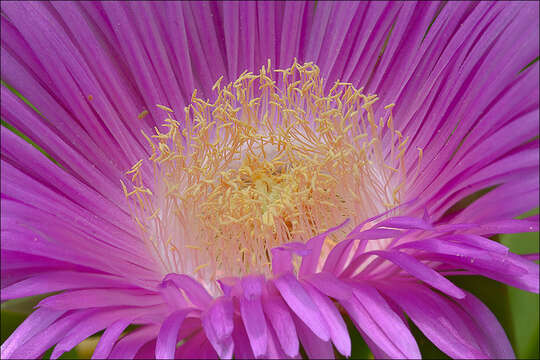Carpobrotus-acinaciformis_3

Description:
Carpobrotus acinaciformis (L.) L. Bo., syn.: Mesembryanthemum acinaciformis Family: Aizoaceae MartinovEN: ice plant, Hottentotsfig, Elands sourfig, Sally-my-handsome, DE: Hottentottenfeige, Hottentot FigSlo: zmajev zob, maji krempelj, CR: sabljasti karpobrotDat.: April 26. 2006Lat.: 44.37505 Long.: 14.78157Code: Bot_0117/2006_DSC0243Habitat: Semiruderal place, abandoned garden, flat terrain, calcareous stony ground; open, sunny, dry place; elevation 20 m (65 feet); average precipitations ~ 1.000 mm/year, average temperature 13-15 deg C; Sub-Mediterranean phytogeographical region. Substratum: soil.Place: Adriatic Sea, island Olib, southeast outskirts of village Olib, Zadar archipelago, Zadar region, Croatia EC. Comment (pertains to Flickr album Carpobrotus acinaciformis): Carpobrotus acinaciformis is a sprawling succulent with large, showy, up to 15 cm diameter, pink-purple flowers. Its leaves are thick, full of water-storage tissue and shaped like a sabre. In cross-section they are sharply triangular. It is native to South Africa. The species was introduced in all five continents, where it is now present as alien or already naturalized plant also in large parts of south Europe and UK. The plant is warmth loving but to some extent frost tolerant. It can survive minimum temperatures down to about -1 or -2 deg C. Still, in Europe it is limited more or less to Mediterranean basin and UK. This fast growing species is a nasty invasive plant capable to eradicate all native vegetation in large areas, sometimes almost from entire islands. However, it is still extensively used in horticulture because of its really showy blooming and also as soil erosion preventing plant. South African Aizoaceae have been grown in Europe for ornamental purposes since the beginning of the seventeenth century. They are undemanding, easy to grow plants because of their high drought resistance and because they are satisfied with nutrients poor soils. The only absolute requirement for prospering is sun, sun, as much as possible of sun. Taxonomically the plants are problematic ones. Apart of several other species of this genus growing in South Africa, Carpobrotus acinaciformis (L.) L. Bo. and Carpobrotus edulis (L.) N.E.Br. subsp. edulis are the most common taxa, which can be found in Europe today. Both have similar environmental requirements and often grow together. However, to differentiate both species is still a problem. Different authors consider different taxonomy and take into account different characteristic traits in their keys. According to Campoy et al. 2018 (Ref.: 8.) Carpobrotus edulis has yellow flowers (albeit var. rubescens has purple-red flowers), leaves are slightly curved, grass-green with +/- equilaterous triangular cress-section, stamens are yellow and ovary has 9 to 11 loculi according to Ref. 8. and 10 to 14 loculi according to Ref. 6.. Carpobrotus acinaciformis has rose-purple flowers, leaves are glaucous (covered by waxy bloom appearing bluish) with isosceles triangular cress-section and are scimitar-shaped (sword like with a curved blade), stamens are purple and ovary has 12 to 16 loculi (Ref. 8.). The plants shown in this post have rose-purple petals, grass-green leaves (with only minute bluish tint when young) and light orange-purple stamens. Leaves shape appear to be somewhere in between Carpobrotus edulis and Carpobrotus acinaciformis. Some are lightly curved, others are distinctly sword like and their cross-section is also between isosceles triangular and equilaterous triangular. The number of loculi is around 12 or 13. This corresponds to Carpobrotus acinaciformis according to Ref. 8. but fits also to Carpobrotus edulis (L.) N.E.Br. ssp. edulis var. rubescens according to Ref.: 6.. So, it is hard to decide, how to name the plants on my photos. After consulting my botanical friends from Croatia, we decided to name them Carpobrotus acinaciformis. This also corresponds to the checklist for the island Olib published in 2016 by Milovi et al., 2016 (Ref.: 7.). It is also possible that this is a hybrid between both taxa. Such hybrids have been reported from South Africa as well as from Europe (Ref.:8.). Carpobrotus edulis has not been found on the island Olib yet. But Flora Croatica Data base (FCD)(Ref.: 9.) states it on island Silba, which is only a few kilometers away of the island Olib. Hybrid swarms between Carpobrotus edulis and Carpobrotus acinaciformis are also known. They were extensively studied, for example, in France (Ref.: 5.).Be that as it may, the taxonomic identity of both Carpobrotus species in Europe and the Mediterranean has long been a subject of debate without generally accepted result. There still exist several taxonomic uncertainties in the genus (Ref.: 9.).Ref.:(1) Personal communication with Ljiljana Boroveki-Voska, Zagreb, Croatia.(2) I. Schnfelder, P. Schnfelder, Kosmos Atlas Mittelmeer- und Kanarenflora, Kosmos, (2002), p 38.(3) D. Seidel, Blumen am Mittelmeer, BLV (2002), p 131.(4) M. Blamey, C. Grey-Wilson, Wild Flowers of the Mediterranean, A & C Black, London (2005), p 116.(5) Suehs, C. M., L. Affre, and F. Mdail. 2004a. Invasion Dynamics of Two Alien Carpobrotus (Aizoaceae) Taxa on a Mediterranean Island: I. Genetic Diversity andIntrogression. Heredity 92 (1): 3140. (6) W.K. Rottensteiner, Exkursionsflora fr Istrien, Verlag des Naturwissenschaftlichen Vereins Krten (2014), p 119.(7) M. Milovi, S. Kovai, N. Jasprica & V. Stamenkovi, Contribution to the Study of Adriatic Island Flora: Vascular Plant Species Diversity in the Croatian Island of Olib, Nat. Croat., Vol. 25:1, 2554 (2016), Zagreb.(8) J.G. Campoy, A.T. R. Acosta, L. Affre, R. Barreiro, G. Brundu, et al.,Monographs of invasive plants in Europe: Carpobrotus. Botany Letters, Taylor & Francis, 2018, 165 (3-4), pp.440-475. (9) Nikoli, T. ed. (from 2005 on), Flora Croatica Database (FCD), Department of Botany, Faculty of science, FER-ZPR, University of Zagreb (2004); hirc.botanic.hr/fcd (accessed Dec.11.2021)
Included On The Following Pages:
- Life (creatures)
- Cellular (cellular organisms)
- Eukaryota (eukaryotes)
- Archaeplastida (plants)
- Chloroplastida (green plants)
- Streptophyta
- Embryophytes
- Tracheophyta (ferns)
- Spermatophytes (seed plants)
- Angiosperms (Dicotyledons)
- Eudicots
- Superasterids
- Caryophyllales
- Aizoaceae (stone plants)
- Carpobrotus (Ice Plants)
- Carpobrotus acinaciformis
This image is not featured in any collections.
Source Information
- license
- cc-by-nc-sa
- copyright
- Amadej Trnkoczy
- photographer
- Amadej Trnkoczy
- original
- original media file
- visit source
- partner site
- Flickr Group
- ID


